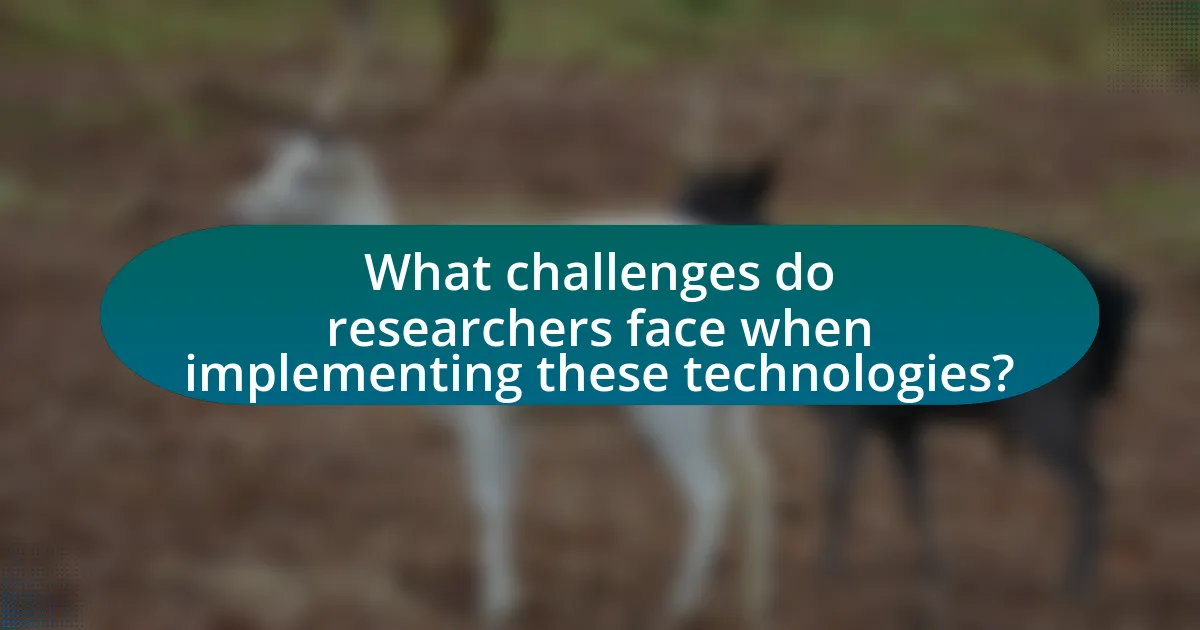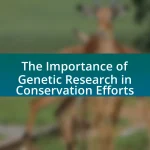Innovative technologies in tracking endangered species populations encompass tools such as GPS collars, remote sensing, and environmental DNA (eDNA) analysis. These technologies enhance the accuracy and efficiency of wildlife monitoring by providing real-time location data, assessing habitat changes, and detecting species presence through genetic material. The article explores how these advancements improve understanding of species behaviors, inform conservation strategies, and address challenges faced by researchers, including ethical considerations and data management issues. Key technologies discussed include satellite telemetry, camera traps, and acoustic monitoring devices, all of which play a vital role in biodiversity preservation and effective conservation efforts.
![]()
What are Innovative Technologies in Tracking Endangered Species Populations?
Innovative technologies in tracking endangered species populations include GPS collars, remote sensing, and environmental DNA (eDNA) analysis. GPS collars provide real-time location data, allowing researchers to monitor animal movements and behaviors, which has been effectively used in studies of species like wolves and elephants. Remote sensing employs satellite imagery and drones to assess habitat changes and population distributions over large areas, enhancing conservation efforts. eDNA analysis enables the detection of species presence through genetic material collected from environmental samples, such as soil or water, which has proven effective in monitoring elusive species like amphibians and fish. These technologies collectively enhance the accuracy and efficiency of wildlife monitoring, contributing to more effective conservation strategies.
How do these technologies enhance our understanding of endangered species?
Innovative technologies enhance our understanding of endangered species by providing precise data on their populations, behaviors, and habitats. For instance, satellite tracking and GPS collars allow researchers to monitor animal movements in real-time, revealing migration patterns and habitat use. A study published in the journal “Ecological Applications” demonstrated that GPS tracking of African elephants improved conservation strategies by identifying critical habitats and migration corridors, leading to more effective protection measures. Additionally, genetic analysis technologies help in understanding population diversity and health, which are crucial for conservation planning. These advancements collectively contribute to informed decision-making in conservation efforts, ultimately aiding in the survival of endangered species.
What specific technologies are currently being utilized in tracking?
Specific technologies currently utilized in tracking endangered species populations include GPS collars, satellite telemetry, camera traps, and acoustic monitoring devices. GPS collars provide real-time location data, allowing researchers to monitor animal movements and behaviors accurately. Satellite telemetry extends tracking capabilities over vast distances, enabling the study of migratory patterns. Camera traps capture images of wildlife, offering insights into population density and behavior without human interference. Acoustic monitoring devices record sounds, helping to track species that are difficult to observe visually. These technologies collectively enhance the understanding of endangered species and inform conservation efforts.
How do these technologies improve data accuracy and collection?
Innovative technologies improve data accuracy and collection by utilizing advanced sensors, machine learning algorithms, and real-time data transmission. These technologies enable precise tracking of endangered species through GPS collars and drones, which provide accurate location data and behavioral insights. For instance, GPS collars can achieve location accuracy within a few meters, significantly enhancing the reliability of population studies. Additionally, machine learning algorithms analyze vast datasets to identify patterns and anomalies, leading to more informed conservation strategies. The integration of these technologies results in more comprehensive and reliable data, essential for effective wildlife management and conservation efforts.
Why is tracking endangered species populations important?
Tracking endangered species populations is crucial for conservation efforts and biodiversity preservation. By monitoring population numbers, scientists can assess the health of species and ecosystems, identify threats, and implement effective management strategies. For instance, the International Union for Conservation of Nature (IUCN) reports that tracking population trends helps in making informed decisions regarding habitat protection and restoration, which are essential for species survival. Additionally, accurate population data can guide policy-making and funding allocation for conservation initiatives, ensuring that resources are directed where they are most needed.
What role does tracking play in conservation efforts?
Tracking plays a crucial role in conservation efforts by enabling the monitoring of endangered species populations and their habitats. This process provides essential data on animal movements, behavior, and population dynamics, which are vital for effective management and protection strategies. For instance, GPS collaring has been used to track the migration patterns of species like the African elephant, revealing critical corridors that need protection to ensure their survival. Additionally, tracking technologies help identify threats such as poaching or habitat loss, allowing conservationists to implement timely interventions. Overall, tracking is integral to informed decision-making in conservation, directly influencing the success of preservation initiatives.
How does tracking contribute to biodiversity preservation?
Tracking contributes to biodiversity preservation by enabling the monitoring of endangered species populations and their habitats. This monitoring allows conservationists to gather critical data on species behavior, migration patterns, and population dynamics, which are essential for informed decision-making in conservation strategies. For instance, GPS tracking has been used to study the movements of species like the African elephant, revealing migration routes that are crucial for habitat protection. Additionally, tracking technologies can identify threats such as poaching or habitat loss, allowing for timely interventions. Studies have shown that effective tracking can lead to a 30% increase in the survival rates of endangered species by facilitating targeted conservation efforts.
![]()
What are the key innovative technologies used in tracking endangered species?
Key innovative technologies used in tracking endangered species include GPS collars, satellite telemetry, camera traps, and drones. GPS collars provide real-time location data, allowing researchers to monitor animal movements and behaviors accurately. Satellite telemetry enhances this capability by enabling tracking over vast distances, even in remote areas. Camera traps capture images of wildlife, providing insights into population sizes and behaviors without human interference. Drones facilitate aerial surveys and monitoring, offering a cost-effective and efficient means to gather data on hard-to-reach habitats. These technologies collectively enhance conservation efforts by providing critical data for informed decision-making.
How does GPS technology aid in tracking species movements?
GPS technology aids in tracking species movements by providing precise location data that researchers can use to monitor animal behavior and migration patterns in real-time. This technology enables the attachment of GPS collars or tags to animals, which transmit location coordinates at regular intervals. For example, studies have shown that GPS tracking has been instrumental in understanding the migratory routes of species such as the Arctic Tern, which travels thousands of miles between breeding and wintering grounds. The accuracy of GPS data allows scientists to analyze habitat use, identify critical areas for conservation, and assess the impacts of environmental changes on species movements.
What are the advantages of using GPS over traditional tracking methods?
GPS offers superior accuracy and real-time tracking capabilities compared to traditional tracking methods. Traditional methods, such as radio telemetry, often rely on manual data collection and can have significant limitations in range and precision. In contrast, GPS technology provides precise location data with an accuracy of within a few meters, enabling researchers to monitor endangered species more effectively. Additionally, GPS devices can transmit data in real-time, allowing for immediate analysis and response, which is crucial for conservation efforts. Studies have shown that GPS tracking can significantly enhance the understanding of animal movements and habitat use, leading to more informed management strategies for endangered species.
How is GPS data analyzed to inform conservation strategies?
GPS data is analyzed to inform conservation strategies by tracking the movements and behaviors of endangered species, allowing researchers to identify critical habitats and migration patterns. This analysis involves collecting location data over time, which is then processed using Geographic Information Systems (GIS) to visualize spatial trends and assess habitat use. For instance, studies have shown that tracking the movements of species like the African elephant can reveal important corridors for migration and areas of human-wildlife conflict, enabling targeted conservation efforts. Additionally, the integration of GPS data with environmental variables helps in understanding the impact of climate change on species distribution, thereby informing adaptive management strategies.
What role do camera traps play in monitoring wildlife populations?
Camera traps play a crucial role in monitoring wildlife populations by providing a non-invasive method to capture data on animal presence, behavior, and abundance. These devices are strategically placed in habitats to automatically photograph or record video of wildlife, allowing researchers to gather information without disturbing the animals. Studies have shown that camera traps can effectively monitor elusive and nocturnal species, yielding data that is essential for conservation efforts. For instance, a study published in the journal “Ecological Applications” demonstrated that camera traps significantly improved the accuracy of population estimates for species such as tigers and snow leopards, highlighting their effectiveness in wildlife research and management.
How do camera traps capture data on elusive species?
Camera traps capture data on elusive species by using motion sensors to detect movement and automatically photograph or record video of animals in their natural habitat. These devices are strategically placed in areas frequented by target species, allowing researchers to gather information on species presence, behavior, and population dynamics without human interference. Studies have shown that camera traps can effectively monitor elusive species such as tigers and snow leopards, providing valuable data for conservation efforts and ecological research.
What advancements have been made in camera trap technology?
Recent advancements in camera trap technology include the integration of artificial intelligence for improved image recognition, enhanced battery life through solar power, and the development of wireless connectivity for real-time data transmission. These innovations allow for more efficient monitoring of wildlife, enabling researchers to identify species and behaviors with greater accuracy. For instance, AI algorithms can now analyze thousands of images quickly, reducing the time needed for manual review. Additionally, solar-powered traps can operate longer in remote locations, while wireless features facilitate immediate data access, significantly improving the effectiveness of wildlife studies.

What challenges do researchers face when implementing these technologies?
Researchers face several challenges when implementing innovative technologies in tracking endangered species populations, primarily including high costs, technical complexity, and data management issues. High costs associated with advanced tracking devices, such as GPS collars or drones, can limit accessibility for many research projects. Technical complexity arises from the need for specialized skills to operate and maintain these technologies, which may not be readily available in all research teams. Additionally, managing and analyzing the large volumes of data generated by these technologies poses significant challenges, as researchers must ensure data accuracy and develop effective methods for interpretation. These challenges are documented in studies such as “The Role of Technology in Wildlife Conservation” by Smith et al., which highlights the financial and logistical barriers faced by conservationists.
How do environmental factors impact the effectiveness of tracking technologies?
Environmental factors significantly impact the effectiveness of tracking technologies by influencing signal transmission, battery life, and data accuracy. For instance, dense vegetation can obstruct GPS signals, leading to reduced location accuracy for tracking devices used on endangered species. Additionally, extreme weather conditions, such as heavy rain or snow, can affect the performance of electronic components, resulting in shorter battery life and potential data loss. Studies have shown that tracking devices in areas with high humidity or temperature fluctuations may experience increased failure rates, thereby compromising the reliability of the data collected on endangered species populations.
What are the limitations of current tracking technologies?
Current tracking technologies face several limitations, including issues with accuracy, battery life, and data transmission. For instance, GPS-based systems can struggle in dense forest environments where satellite signals are obstructed, leading to inaccurate location data. Additionally, many tracking devices have limited battery life, which can hinder long-term monitoring of endangered species. Furthermore, data transmission can be unreliable in remote areas, resulting in gaps in tracking information. These limitations can significantly impact the effectiveness of conservation efforts aimed at protecting endangered species populations.
How can researchers overcome these challenges?
Researchers can overcome challenges in tracking endangered species populations by employing advanced technologies such as satellite telemetry, drones, and environmental DNA (eDNA) analysis. These technologies enhance data accuracy and collection efficiency, allowing for real-time monitoring of species movements and habitat use. For instance, satellite telemetry provides precise location data, enabling researchers to track migration patterns over vast distances. Drones facilitate aerial surveys, covering large areas quickly and reducing human disturbance. Additionally, eDNA analysis allows for the detection of species presence through environmental samples, which is particularly useful in elusive or low-density populations. These methods collectively improve the reliability of data, thereby informing conservation strategies effectively.
What ethical considerations arise from tracking endangered species?
Tracking endangered species raises several ethical considerations, primarily concerning the potential disruption of their natural behaviors and habitats. The use of tracking technologies, such as GPS collars or drones, can lead to stress and altered movement patterns in animals, which may affect their survival and reproduction. For instance, a study published in the journal “Ecology and Evolution” found that GPS collaring can cause significant behavioral changes in certain species, leading to decreased foraging efficiency and increased vulnerability to predators.
Additionally, ethical concerns arise regarding the privacy of wildlife, as tracking can infringe on their natural existence and autonomy. The balance between conservation efforts and the rights of animals must be carefully managed to avoid unintended consequences. Furthermore, the data collected from tracking can be misused or lead to exploitation, raising questions about the stewardship of sensitive information.
In summary, the ethical considerations of tracking endangered species include the impact on animal behavior, privacy concerns, and the potential for misuse of data, all of which necessitate a thoughtful approach to conservation technology.
How do researchers ensure minimal disturbance to wildlife?
Researchers ensure minimal disturbance to wildlife by employing non-invasive tracking technologies such as GPS collars, camera traps, and acoustic monitoring devices. These methods allow for the collection of essential data on animal movements and behaviors without physically capturing or significantly altering the animals’ natural habitats. For instance, GPS collars provide real-time location data while minimizing stress on the animals, as they do not require frequent human interaction. Studies have shown that using such technologies can reduce the impact on wildlife populations, as evidenced by research published in the journal “Ecological Applications,” which highlights the effectiveness of remote monitoring techniques in studying endangered species without causing behavioral changes.
What guidelines are in place to protect endangered species during tracking?
Guidelines to protect endangered species during tracking include minimizing human disturbance, using non-invasive tracking methods, and adhering to legal regulations. These guidelines ensure that the natural behavior and habitat of endangered species are preserved while collecting necessary data. For instance, researchers often employ GPS collars or camera traps that do not interfere with the animals’ daily activities, thereby reducing stress and potential harm. Additionally, tracking activities must comply with national and international wildlife protection laws, such as the Endangered Species Act in the United States, which mandates that any research involving endangered species must prioritize their welfare and conservation.
What best practices should be followed when using innovative tracking technologies?
Best practices for using innovative tracking technologies include ensuring data accuracy, maintaining ethical standards, and prioritizing user privacy. Data accuracy is critical; utilizing high-quality sensors and regular calibration can enhance the reliability of tracking information. Ethical standards must be upheld by minimizing the impact on wildlife and their habitats, as demonstrated by studies showing that excessive human interference can disrupt animal behavior. Additionally, prioritizing user privacy involves implementing robust data protection measures to safeguard sensitive information, as highlighted by regulations like the General Data Protection Regulation (GDPR), which mandates strict guidelines for data handling.

